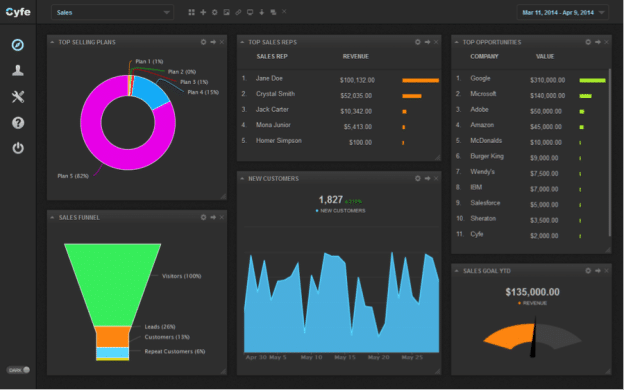On its best day business is fuzzy. If it were simply black and white, everyone would be crushing it. Instead, we do our best to make intelligent guesses that keep us moving forward, but the smartest among us use metrics and automation tools to help clear up the fuzziness allowing for informed, intelligent, data-driven, action plans.
Metrics may be applied to help improve any and every part of the business process from sales and marketing to human resources, productivity, and finance. There is no need to take a best guess when data is precisely pointing us in the best direction.
The key here is that when used properly, analytics save us the two most important components of business: time and money. Assuming you’re interested in both of those assets, read on…!
What Are Business Intelligence Data Points?
Good question — what do we mean when we’re talking about business intelligence? Investopedia defines business intelligence as a “… a broad term that encompasses data mining, process analysis, performance benchmarking, descriptive analytics, etc. ”
While entirely accurate, that sounds a bit complicated, so to simplify, business intelligence (often referred to as BI) data points focus mostly on internal company processes. We will specifically focus on project management, the sales cycle, and finance, but understand that business intelligence data points may reach far beyond this scope. It all comes down to your company’s unique mission, goals, and key performance indicators.
How to Improve Business Decisions with Business Intelligence Data Points
For better or worse, the numbers don’t lie. Once business goals are defined, targets are either hit or missed. Sure, the goal may change, but knowing exactly where the company lands is essential in measuring success, finding out what to improve, and achieving continued growth.
Pro tip: Useful at-a-glance metrics are by default immediately actionable. So, take action!
Project Management
Measuring and analyzing project management data points are essential to any successful business running any type of project from agile scrum and product development to the most basic of event planning or coordination. Finding opportunities to leverage project management productivity can be a tremendous cost- and time-saving endeavor as it speeds up processes and boosts efficiencies.
Here are a few key metrics worth analyzing and reasons why you should be monitoring them.
- Task management and to do’s:
This may seem straightforward, but tracking tasks and due dates, while seemingly the most simple of organizational procedures, often gets left behind when multiple people and teams are working fast on various projects. Task management analytics help people stay on track, prevents blockers, and holds everyone accountable throughout the project until it is complete. Tracking these data points additionally makes for easy project review when looking at lessons learned and potential improvements for next time.

- Time management:
Track how much time is needed for each task. Be sure you are charging or paying for your time accordingly and always be sure of where the overall timeline of the project stands. With accurate information, you can manage overall timeline expectations and adjust the scope of the project accordingly. For many businesses, charging by the hour is the norm and accurately tracking your hours will help you to provide more accurate and profitable estimates and proposals in the future.
- Benchmarking:
Most projects require benchmarking or healthy baseline check ups before, during, and even after developing particular tasks. Use business intelligence metrics to track competitors and analyze audience or potential customer data. Uncover user-persona trends that may inform your business’ marketing and sales strategy. Maintain a dashboard that holds this information so that it may be easily shared among your team members and other key stakeholders.
The Sales Cycle
Here’s a glimpse of a business intelligence analytics dashboard from Cyfe that showcases the kinds of sales cycle metrics worth tracking to find pockets of growth potential. This particular dashboard is showcasing a sample company’s sales metrics.

Now let’s break some of business intelligence analytics down into actionable insights.
- Top sales representatives (measured by total earned company revenue): Knowing (and not guessing) which sales representatives land squarely in, for example, the top ten percent of total company revenue generation will help you make more informed managerial decisions. And these are easier decisions to make because they are based on data. Do you know who your best (and worst) salesmen really are? I’m sure your gut tells you one thing, but the data may actually reveal a different story. Let your analytics tell the true story.
- Top sales opportunities (determined by total target value):
If you don’t know what your goals are, it’s nearly impossible to achieve them. Use an analytics dashboard to thoroughly understand your target market and share that data with your team in real time. Giving your sales team a better understanding of which prospects and leads are closest to the sale will help them better utilize their time and prioritize bottom of the funnel opportunities.
- Lead to customer conversion rates: Know your conversion rates. Know your cost per conversion. Use this data to make marketing pivots, personnel shifts, and hiring decisions. Focus your budget on attaining the type of leads that are most likely to convert and do so with confidence. Through this data you’ll be able to identify which types of leads, which sources, and which conversion paths will likely yield more customers.
- New customer acquisition: Learn when and from where your customers are being acquired. Tweak your sales and marketing strategies accordingly so that you can get the most bang for your buck. For example, if you find that yours is a seasonally based business and that the majority of your new customers sign up during the summer months, target that time to give your branding a boost.
Finance
Maintaining a healthy financial status is the ultimate goal of business. It’s a simple formula — make more than you’re spending. But when companies fail to make time to properly track financial business intelligence data points, they fail. Here are some key financial metrics to know and some insights that will drive success…
- Business expenses: If you don’t know what is being spent, you’re in trouble. Properly sorted data points will analyze business expenditures broken down by department, team, and even individual. Use metrics to discover where cash is moving and to determine if it’s being appropriately allocated and spent.
- Invoices: Be sure to get paid! By tracking invoice payments and schedules, you’ll know when you are owed money, how much, and by whom. One of the easiest ways for a business to fail is to have lots of overdue accounts receivable. Being too lenient or passive in collecting on your accounts is a recipe for disaster. Understand what you’re owed and implement strategies to get paid, on time.
- Overall company revenue: This is a big one, and perhaps it’s a bit obvious, but knowing gross and net total company revenue is a no brainer for any business interested in improvement and growth. Use this metric to learn what company challenges may need immediate attention. It’s important to understand, especially for a brand new business, that sales and revenue are not the same thing as profit. It’s very important to know your gross numbers, but taking it a step further to understand your net sales numbers will help you implement procedures to move into the black.
- Budgets: While it’s important to understand total company revenue and expenses, the ability to track departmental budgets at-a-glance is incredibly useful in making predictions or when needing to cut costs. Know where the financial health of the business stands at any given point in time. Do you have departments or areas of your business that are surpassing their budgets? How will that be handled when it comes up? Figuring all of this out now will eliminate major issues in the future.
What If the Data is Less Than Stellar?
If the data shows something that you or your CEO doesn’t like — and this will happen — think of it as an opportunity for growth. First, consider shifting perspectives; adjust the date range, change filters, adjust your overlays. (Heck, be sure to check the numbers)!
But mostly, be open and willing to pivot to achieve your business goals. And if your primary business goal is growth, business intelligence analytics is a critically essential way to expand by saving time and money and by discovering ways in which to boost productivity.
Success demands a pointed strategy and the data will get you there, but it also requires finesse along with a healthy dose of creativity. After all, business can’t be entirely black and white. If that were the case, it would be incredibly dull. By its very nature, business will always be at least somewhat fuzzy, and we wouldn’t want it any other way.
Get started with Cyfe today for free. Go ahead, give it a try and discover how business intelligence analytics deliver the hard core data needed to grow your business. No credit card. No obligation. Just insight!



